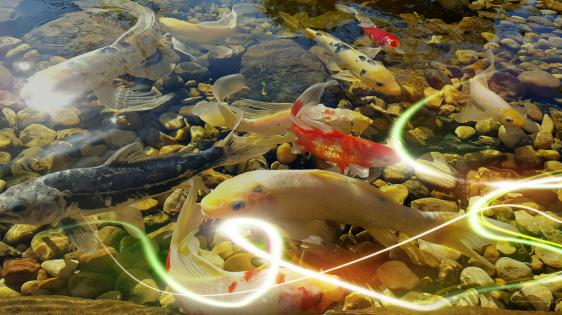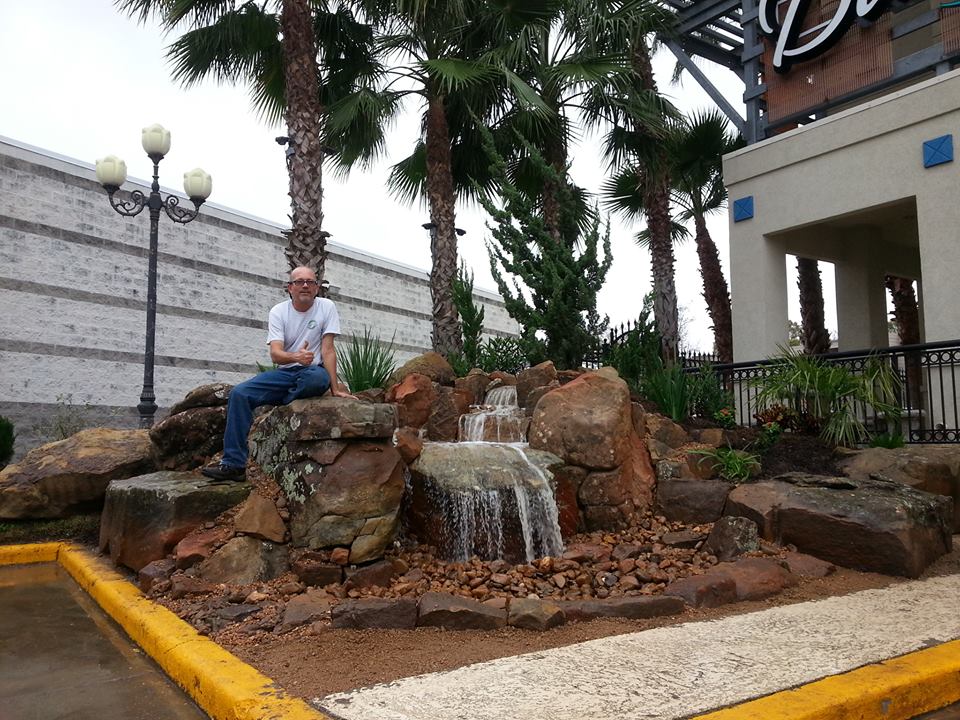Texas Pond-erings
Are the Koi and Other Fish in my Austin, TX Central Texas Backyard Pond Happy or Bored?
by Matt Boring on 12/18/16
I was talking to our crew leader Mando recently about the fish in our ponds. I had noticed that unless they think they're about to get fed, they spend quite a bit of their time mouthing away at the rocks and gravel in the pond. They're constantly searching around for little bits of algae, insect larvae, tiny fish, worms and other edible organic material that make up their diet. They're perfectly content doing in our Central Texas backyard ponds what they would do in a natural pond which is forage, pretty much. And they're receiving a similar diet, along with some Koi Pellets a couple of times a week. They seem happy to be constantly interacting with their environment in a way that is natural to them.
Those little 'whiskers' or barbels near the mouth of a Koi or a catfish are sensory organs that help them detect edible material on the bottom in murky water. In nature, these are responsible for making sure these fish get enough to eat. Foraging at the bottom is the natural instinct of these types of fish. It's the behavior nature equipped them for. In backyard ponds with gravel, they get a more healthy balanced diet AND they help keep the pond clean. The gravel at the bottom promotes the growth of beneficial bacteria that break down the fish waste and convert it into useable nutrients for the plants to take up. A clean-out every year or two helps to remove sediments and things that the system can't 'digest'.
Watch a one-minute video showing some happy fish!
Now contrast that with a pond that has a bare black liner or a concrete 'dedicated' Koi pond with smooth sides and bottom. In systems like that without a bottom drain, the fish waste and sediments begin to build up in a layer on the bottom. The Koi don't want to root around it in. So they just swim around aimlessly. Even in ponds with a bottom drain in which the waste doesn't build up on the bottom, the fish have nothing to do except swim around and wait to be fed. Their natural instincts to forage are frustrated because of their environment. They become prisoners in their own ponds with nothing to do but pace their cell. If you stick a lily in there in its pot, you'll soon see their natural instincts take over as they will root through the soil searching for edible materials, turning over and destroying the lilies. In our ponds, the lilies grow out of the gravel substrate and the fish don't mess with them, except to eat the spent pads and blossoms.
I am not a licensed fish psychiatrist and I don't play one on TV. However, I would assume that an environment that most closely replicates a natural one for these fish would lead to happier healthier fish. The balanced ecosystem in nature that provides them food and something to do with their time will do the same in your backyard pond in Austin Texas.
Disappearing Pondless Waterfalls are a Natural Addition to any Austin or Central Texas Landscape
by Matt Boring on 12/01/16
One of the most relaxing sounds you can experience in nature is the sound of moving water. Whether you're near the beach where you can hear the steady sound of the surf crashing or in the forest near a softly gurgling creek or in the mountains with a roaring waterfall in the background makes little difference. Like a gentle rain on a tin roof in the summertime, it just calms you down for some reason. When I started building ponds in Austin, Texas over sixteen years ago, I was amazed at how the customers' yards would come to life once the pump was plugged in for the first time. Instantly there was motion where there was none before. And there was that wonderful noise! Every waterfall sounds different because of how they are constructed and how the stones are placed, but every one sounds amazing and ultimately relaxing.
Click to watch a video about pondless waterfalls.
Some people here in Central Texas don't want a pond or can't put one in the location that they want to see and hear the splashiness of a waterfall. A pondless waterfall is a perfect option for those situations. A pondless waterfall doesn't have an open body of water like a pond at all. Instead, the water cascades down the waterfall and seems to disappear into a bed of decorative gravel at the end. All the water is held underground and recirculated through the feature with a hidden pump. Nothing artificial shows. You only see natural rocks and water. You can even incorporate a stream into your pondless waterfall design.
Like the waterfalls we build on the sides of our ecosystem ponds, we build our pondless waterfalls to look natural, but also to our customers' wishes. For instance, if people want wide flat sheets of water flowing over flat level rocks, we can do that for them. If they prefer to see the water splashing and gurgling over the natural shapes of the stones, we can do that as well. We use natural Moss Rock boulders from right here in Central Texas in all our installations. We find that this type of stone really add a lot of character to our work. With lichens and even actual moss growing right on the stones, they have an aged look that helps make our waterfalls look like they have been there for eons.
A small disappearing waterfall installed here in Austin or Central Texas where we don't have to drive too far can start as low as $5000 if you have an existing slope. Normally we have to bring in soil to create the berm around the waterfall that helps make it look natural. In small spaces we have to create a retaining wall to contain the berm. Those pondless waterfall features typically start at $7000 in the Austin Texas area and they come with a remote control. With the remote you can adjust the speed of the waterfalls as well as turn the feature on and off!
Watch us create a $7000 Disappearing Pondless Waterfall
Pondless waterfalls attract birds as well. They will show up each day to drink from and bathe in the stream. They can also provide water to nearby wildlife in drought conditions.
Contact us today to get started on your pondless waterfalls in the Austin, Central Texas area. 512-782-8315
Do I need a Pond Heater in my Backyard Koi Pond in the Austin or Central Texas Area?
by Matt Boring on 11/20/16
Since we just experienced our first freeze this year here in the Austin Texas area, I wanted to address this question on my very first blog. I've been building ecosystem ponds, disappearing pondless waterfalls, and other water features in this area professionally for over 16 years. So whatever I share with you is based on many years of experience, not something I just read in a book or online. A lot of people wonder if they need a pond heater to keep their fish alive in Central Texas during the winter. All pond owners love their Koi, goldfish, turtles, and other pond inhabitants and want to make sure that they are safe when the temperatures drop.
The Koi, Shubunkins, Comets, and other fish typical to a backyard ecosystem pond are cold blooded beings. As the water temperature drops, their metabolism slows and they move less. However, they are fine. Here in Central Texas, the temperatures never stay cold enough long enough to freeze the top of most ponds. The purpose of a pond heater is to keep a hole open in the ice so that the hibernating fish still get oxygen and they don't suffocate. It's not to heat all the water in the pond. Imagine what that would do to your electric bill here in Austin!
In Texas, in a typical in-ground backyard fish pond around two feet deep, the heat from the surrounding earth keeps the water warm enough to keep the ice from ever forming on the surface. And the fish will go hang out in the lowest level of the pond where the water is the warmest. So they are completely fine. In fact, into Chicago and even Canada, the fish are just fine to overwinter in the pond. In most of Texas, just keeping your waterfall running is sufficient to make sure that the pond's surface doesn't freeze.
The main thing you have to be careful of when it's really cold is that ice dams don't form in the waterfall and stream and divert water outside the liner. If that happens, you can simply turn off the pump. If you live in a climate that is cold enough to freeze the surface, you have several options. You can remove your pump from the skimmer and place it in the pond so that it agitates the surface enough to keep a hole open in the ice. You can use a professional aerator on a shallow pond shelf. The bubbles rising to the top should keep the ice from freezing the entire surface. The gases from the pond and the surrounding atmosphere need to be able to be exchanged to keep the fish safe. Only if your climate is really cold, will it warrant a floating de-icer.
One other important thing to remember is that once the water temperature is below 50 degrees, stop feeding your fish. You may also want to switch to a cold water formulation of beneficial bacteria.
Please visit our website at www.TexasPonds.com and follow us on Facebook at www.Facebook.com/TexasPonds to stay up to date and see lots of beautiful pictures.
Until next time...........Happy Pondering!

